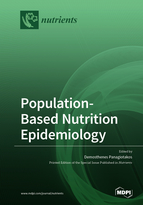Population-Based Nutrition Epidemiology
A special issue of Nutrients (ISSN 2072-6643). This special issue belongs to the section "Nutritional Epidemiology".
Deadline for manuscript submissions: closed (31 October 2020) | Viewed by 49065
Special Issue Editor
Interests: chronic disease epidemiology; nutritional epidemiology; public health; Mediterranean diet
Special Issues, Collections and Topics in MDPI journals
Special Issue Information
Dear Colleagues,
Nutritional epidemiology examines dietary or nutritional factors in relation to the occurrence of disease in various populations. It is a fact that substantial progress has been made in recent years in nutritional epidemiology. Compared to the practice during the 1990s, and with the improvements in data analytics, several new approaches are gaining ground. Results from a variety of large-scale studies in the field of nutrition epidemiology have substantially contributed toward the evidence used in guiding dietary recommendations for prevention of cardiovascular diseases, metabolic disorders, some types of cancer, and other morbidities.
In this Special Issue, we would like to bring readers closer to the state-of-the-art in the field by gathering papers covering different aspects of nutrition epidemiology from population-based observational studies. Topics of the submitted articles may, but not necessarily, include eating habits of various populations, especially of those not well-studied, such as in Africa, Oceania, South Americas, immigrants, minorities, as well as a variety of associations between nutrients/foods/food patterns and chronic diseases, like cardiovascular, diabetes, obesity, cancer, etc., and gene–nutrient and epigenome–nutrient interactions related to human health at all ages. Articles on the study of nutrition on healthy aging, longevity, and well-being are more than welcome. In addition, methodology articles in the field of nutrition assessment in population-based studies, or data-analytics of large databases in nutrition epidemiology may also be submitted. Original research articles and reviews (systematic reviews and meta-analyses) are welcome.
Dr. Demosthenes Panagiotakos
Guest Editor
Manuscript Submission Information
Manuscripts should be submitted online at www.mdpi.com by registering and logging in to this website. Once you are registered, click here to go to the submission form. Manuscripts can be submitted until the deadline. All submissions that pass pre-check are peer-reviewed. Accepted papers will be published continuously in the journal (as soon as accepted) and will be listed together on the special issue website. Research articles, review articles as well as short communications are invited. For planned papers, a title and short abstract (about 100 words) can be sent to the Editorial Office for announcement on this website.
Submitted manuscripts should not have been published previously, nor be under consideration for publication elsewhere (except conference proceedings papers). All manuscripts are thoroughly refereed through a single-blind peer-review process. A guide for authors and other relevant information for submission of manuscripts is available on the Instructions for Authors page. Nutrients is an international peer-reviewed open access semimonthly journal published by MDPI.
Please visit the Instructions for Authors page before submitting a manuscript. The Article Processing Charge (APC) for publication in this open access journal is 2900 CHF (Swiss Francs). Submitted papers should be well formatted and use good English. Authors may use MDPI's English editing service prior to publication or during author revisions.
Keywords
- Population-based
- Nutrition
- Diet
- Chronic disease







